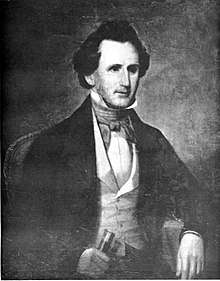Robert Ruffin Barrow
Robert Ruffin Barrow (1798 - 1875) was an American sugar planter and slave owner from Louisiana. He owned a dozen plantations in Louisiana and Texas, and hundreds of slaves, in the Antebellum era. He financed the construction of submarines for the Confederate States Navy during the American Civil War.
Robert Ruffin Barrow | |
|---|---|
 | |
| Born | 1798 North Carolina, U.S. |
| Died | 1875 |
| Occupation | Planter |
| Spouse(s) | Volumnia Washington Hunley |
| Children | 1 son, 1 daughter |
| Parent(s) | Bartholomew Barrow |
| Relatives | Horace Lawson Hunley (brother-in-law) |
Early life
Barrow was born in 1798 in North Carolina.[1][2] His father owned Afton Villa.[1]
Career
Barrow was one of the largest landowners in Terrebonne Parish, Louisiana,[3] where he owned six plantations: Residence, Caillou Grove, Honduras, Myrtle Grove, Crescent Farm, and Point Farm. Residence Plantation took its name from the fact that Barrow regarded it as his home. Its main house Residence Plantation House is currently on the National Register of Historical Places. He also owned the Donaldsonville Plantation in Ascension Parish, the Locust Grove Plantation in Assumption Parish, the Oak Grove Plantation in Lafourche Parish, and several plantations in Texas.[1] He became "one of the wealthiest planters" in Louisiana, and the owner of hundreds of slaves.[4]
During the American Civil War of 1861-1865, Barrow financed the construction of submarines for the Confederate States Navy.[5] He lost much of his wealth as a result of the war, however much was regained back to his family and descendants.[2]
Barrow was politically active in Louisiana.[2]
Personal life, death and legacy
Barrow married Volumnia Washington Hunley, the sister of Confederate Navy officer Horace Lawson Hunley,[5] in 1850. They had a son, Robert Ruffin Jr., and a daughter, Volumnia Roberta.[1]
Barrow died in 1875.[2][4] His daughter Roberta, who inherited his Residence Plantation in Terrebone Parish, built the Residence Plantation House, now listed on the National Register of Historic Places.[6]
References
- "Collection Title: Robert Ruffin Barrow Papers, 1811-1858". The Southern Historical Collection at the Louis Round Wilson Special Collections Library. UNC. Retrieved June 12, 2018.
- "Mr. R. R. Barrow". The Times-Democrat. July 29, 1875. p. 4. Retrieved June 12, 2018 – via Newspapers.com.
- "Some Large Landholders of Terrebonne Parish, 1850". Louisiana History: The Journal of the Louisiana Historical Association. 32 (4): 416. Autumn 1991. JSTOR 4232910.
- "Death's Doings". New Orleans Republican. July 29, 1875. p. 1. Retrieved June 12, 2018 – via Newspapers.com.
- Smith, Claiborne T., Jr. "Barrow, Robert Ruffin". NCPedia. Retrieved June 12, 2018.
- "National Register of Historic Places Inventory/Nomination: Residence Plantation House". National Park Service. Retrieved June 12, 2018. With accompanying pictures